TTECHNOLOGY TRENDS
Exploring the Future of Maritime Innovation



2ABS Technology Trends






THE MARITIME INDUSTRY is no stranger to innovation, but like much else in shipping, the process is cyclical. New ideas and approaches tend to come in waves rather than in a steady stream, often driven by external forces like global conflict, transitions in energy patterns and the global sustainability movement.
ABS has earned its pedigree of developing groundbreaking technologies that have supported the maritime industry. We have recognized for some time that the next wave of innovation is coming, and we need to be ahead of it. To that end, we have built a technology foundation to innovate in a new digital landscape across industry sectors and processes, to equip the marine and offshore industries for important challenges as they transition into digitalized operations on a sustainable trajectory to net-zero carbon.
This has involved adopting techniques from other industries like aerospace and automotive, such as product life-cycle management databases, natural language processing (NLP) and multi-physics modeling and simulation.

Today, we are ready to leverage our recent transformations to enable the industry to adopt a new level of technology that is more familiar to Silicon Valley. Technologies like digital twins, augmented reality (AR), autonomy and artificial intelligence (AI) are changing maritime and must be added to our Rules, standards and the service infrastructure for which we are known.
As we evaluate the role these advanced technologies could potentially play in the industry and how we can support their implementation, we recognize that they fit into three key areas that reflect broader industry trends. The areas of digitalization, applied research and the clean energy transition encompass several technologies poised to revolutionize marine and offshore industries.
Visualization — New visualization technologies like AR and mixed reality (MR) are advancing rapidly. These technologies are no longer reserved for arcades or home video game systems. They have the potential to provide users with realistic virtual representations of assets that can play an essential role in training and inspection. Combined with advanced sensor information, visualization technology could provide a user with real-time and historic information for a vessel or offshore asset, possibly aiding in future autonomous or remote-control functions.
AI — AI has long existed in science fiction stories, but the technology is quickly becoming a part of everyday life both onshore and at sea. The continued evolution and maturity of AI and machine learning (ML) will transform how data is structured, used and optimized in applications throughout an asset’s life cycle. Advances in AI and ML can support the development of sophisticated digital twin models and could eventually enable effective condition-based maintenance.
Autonomous Functions — Autonomous functions offer the potential to enhance safety on board marine vessels or offshore assets by reducing human involvement in high-risk operations. The technology could initially assist in repetitive or dangerous tasks but could eventually scale to be used on board fully autonomous assets. Autonomous functions could play a more significant role in maritime as increasingly complex asset systems are employed, cloud and edge computing power increases, and advanced


Materials — Increasingly complex and efficient assets necessitate advanced materials and more efficient manufacturing approaches. Additive manufacturing (AM) is the process of fusing physical materials to make objects from digital models, potentially limiting the waste associated with subtractive manufacturing. New fit-for-purpose materials, such as graphene, carbon nanotubes and nanostructure-based coatings, could become prominent in enabling greater control over properties of additive manufactured parts compared to traditional cast parts. Ceramics, corrosion-reducing materials and other special-use materials could also be important for the future of marine equipment and assets.
Carbon Capture — The journey to netzero emissions by 2050 will require a combination of solutions. Carbon capture has the potential to be an essential centerpiece in the global

energy transition puzzle, enabling the continued use of hydrocarbons while the production of other low-emission fuels scales to meet industry needs. Carbon capture is a process that aids in reducing emissions by capturing carbon dioxide (CO2) from point sources, such as engine exhaust. It can also capture emissions during the carbon-intensive production of alternative fuels, such as blue ammonia or hydrogen. This could enable the use of such fuels, either for propulsion or other energy needs, while lessening the environmental impact of their production. In addition, CO2 carriers will be needed to transport captured CO2 — either to storage facilities or commercial utilization — and could be a key part of the new carbon economy.
Electrification — Increased electrification via advanced energy storage systems (ESS) will also serve an essential role in the path to decarbonization. ESS such as batteries, kinetic ESS or supercapacitors offer broad application potential. They could be used in a hybrid arrangement, improving the efficiency of hydrocarbon-burning vessels. ESS
could also be used in the small-scale production of green alternative fuels for powering various systems. Use of advanced ESS is expected to see increased use on board marine vessels and offshore assets as we approach 2050.
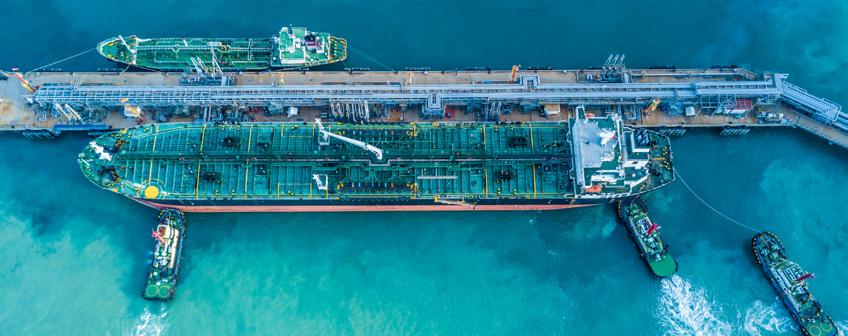
Alternative Energy — Advances in alternative energy systems, such as fuel cells, hybrid systems and nuclear power, will be pivotal to the goal of complete decarbonization of the global fleet. As international regulations evolve and advanced reactor development matures, nuclear power has exciting potential for providing maritime industries with a zero-emission energy source. Ongoing development in new types of reactors aims to commercialize nuclear reactors in relatively small, plug-and-play platforms, providing assets with energy for years before refueling.
OTHER AREAS explored in this document include developments in digital twins, modeling and simulation, generative design, alternative fuels, green ecosystems and the blue economy. These technologies represent significant industry paradigm shifts: future fuels and energy sources, approaches to design and construction that reflect digital processes, software that empowers people and analysis that feeds back into the design and production phases. These shifts demand we approach them with a fresh mindset and new tools, prompting us to elevate to a new performance level and leverage new technologies.
As we move into the future, we recognize that we need to adapt to meet these growing challenges and build upon the learning, standards and continuous improvement we’re known for.
Critical to this mission is keeping the human element front of mind, even as automation, AI and autonomous functions gain prevalence in our industry. These technologies have the potential to provide myriad data about the real-time status of an asset, but the human factor will likely remain a key part of the decision-making process for the foreseeable future. Therefore, training humans for the safe and effective implementation of these technologies remains essential. The human element is not diminished by new technology; instead, it is brought into sharper focus.
ABS has always been a learning organization and one that has supported the industry in adopting new technologies safely — a commitment at the core of what we do. As we move into the new digitalization era, the people at ABS and within the industry are enabling this transformation and supporting the implementation of advanced technologies.

We set forth the roadmap of how we propose addressing the industry’s urgent needs and showing the leadership it expects. In leveraging technologies from other sectors while applying core commercial technologies like cybersecurity and streaming video, we can see what is possible for shipping and offshore — and work to deliver it.
Through close collaboration with industry partners and leaders, we are pleased to offer this glimpse into the technology trends of the future.
•
ALTERNATIVE ENERGY | Widespread Adoption of Alternative Power
• Increased prevalence of hydrogen fuel cells, hybrid systems and nuclear energy
• Improved efficient power generation technology from alternative energy sources
• Safe and sustainable byproduct waste management
ALTERNATIVE
• Global adoption of low- and zero-carbon fuels
• Scaled up zero-carbon fuel generation and distribution

• New efficient zero-carbon fuel engines
• Improved storage for short haul and deepsea use
• Enlargement of distribution substation network
• Global adoption of carbon capture technologies Increased reach of carbon capture transport network
•
•
• Continued development of offshore charging substations infrastructure
• Floating offshore windfarms at scale
Complex integrated energy management systems • New materials and processes • Improved ship connectivity • Increased application of autonomous functions • Real time performance optimization • Fully integrated green ecosystem • Expanded blue economy

VISUALIZATION
•
•
•
•
•
•
•
•
Digital Twin Metaverse. The digital twin metaverse connects various digital twins, AI and advanced simulations to optimize decision-making across all assets Visualization technologies, such as AR, VR and MR, can enable a fully immersive experience for users in the digital twin metaverse
Haptic Applications. A haptic suit can be used to provide the user with physical touch feedback based on their interactions with the virtual environment Haptic feedback could potentially be useful in training scenarios or operating remote vehicles or vessels
shifted to remote operations during the COVID-19 pandemic, it changed how people think about performing and visualizing tasks. Whether because of social distancing measures, on-site safety risks or other unique preclusions, it’s not always practical for a person to be in a particular setting. Even if they can be on-site, their access to physical information about a system might be limited.
Virtual reality (VR), AR and mixed reality (MR) technologies offer new ways to visualize various operational tasks either
on-site or remotely. These visualization technologies have the potential to support a variety of areas, including training, maintenance and remote-control functions as the technologies advance.
VR and AR are relatively mature and limited in scope, presenting users with visual content through wearables like head-mounted displays (HMD) or using hand-held devices such as tablets, laptops or smartphones. However, changing social norms impacting remote work and recent advances in connectivity, computational power and battery capacity introduce new applications for VR, AR and MR.
VISUALIZATION technology is poised to completely change how humans learn about and interact with an asset’s systems. Technological improvements in visualization technologies can improve operations’ efficiency on board marine vessels or offshore assets.
MR blends virtual and physical worlds and allows users to interact directly with virtual environments. This offers substantial potential to support education and training with interactive experiences when there is limited or no access to the physical environment.
An example use case for MR training would be experiencing dangerous situations on board an offshore asset or a vessel at sea. MR technology can replicate and produce a user experience such as a fire or catastrophic component failure without impacting facility operations or production for training purposes. Routine tasks like physical interactions with safety equipment or learning crucial steps for reducing risk can be simulated or visualized before setting foot on a real-world asset where hazards are present.
VR, AR and MR could work with edge computing and digital twins to provide visual information for systems that cannot be perceived directly, such as the inner workings of an operating pump. This information could provide an in-depth understanding of a system and be used for operational decisionmaking, like condition-based maintenance.
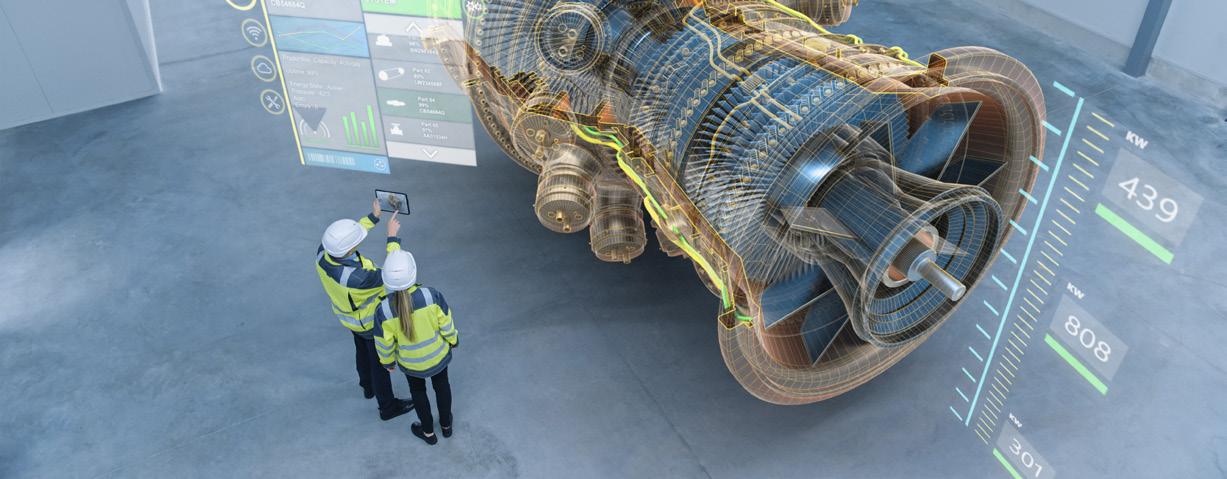
As visualization technology advances alongside other areas of digitalization, it could play an essential role in the implementation of autonomous and remote-control systems. An entire virtual crew could access a vessel remotely and manage or monitor various functions. When vessels become fully autonomous, a single person could virtually connect to a digital twin and manage the entire system.
Advances in multisensory visualization technologies, which incorporates other senses like touch, could open the technology to even more applications. A haptic suit could be combined with other visualization technology to provide crucial physical feedback during particular tasks, such as piloting a subsea remote-operated vehicle.
AI-based Health Monitoring
Self-aware and Self-maintaining Systems
Cognitive Computing

Managing Risks of AI. As AI becomes more prevalent and is applied to more complex systems, there are growing societal and industrial concerns about AI’s ability to remain lawful and ethical Trustworthy AI* is a term to describe a technically robust AI at its fullest potential that acts lawfully and ethically while accounting for its social environment . The High-Level Expert Group on AI published the Ethics Guidelines for Trustworthy Artificial Intelligence in 2019, setting seven key requirements that AI systems must meet to be deemed trustworthy These include human oversight, technical robustness and safety, privacy and data governance, transparency, fairness, societal and environmental well-being and accountability .
HOLLYWOOD CONCEPT ARTIST Syd Mead wrote in his autobiography, “science fiction is reality ahead of schedule.” While AI was long a cornerstone of science fiction stories — with depictions ranging from self-flying cars to robot armies — the reality of AI is rapidly catching up to the stories and finding its way into everyday life.
Broadly speaking, AI is the ability of a computer to make rational, human-like decisions in dynamic situations. Self-driving cars, robotic systems and speech recognition in smartphones might make
the headlines, but the foundation of these AI advances is data analytics and automated decisionmaking. ML and NLP are already serving important data analysis roles in several industries, including medical, agronomy, inventory management, finance and more.
As computational power and vessel connectivity increase, AI will play an expanding role in how marine vessels and offshore assets are managed, repaired and operated.
*Trustworthy AI in this publication refers to AI that acts lawfully and ethically, not the company named Trustworthy AI.
ABS My Digital Fleet’sTM coating assessment platform uses AI to scan visual data and report on a vessel’s condition.ML HAS THE POTENTIAL to serve as the backbone of AI implementation in the marine and offshore industries.
Powered by ML systems, NLP and machinery monitoring and analysis can perform essential functions on connected vessels and offshore assets.
Automated decision-making systems are derived from ML, which uses data to discover patterns and relationships and adapt as patterns evolve. NLP enables conversational human-computer interactions — or even human-to-human interactions in the case of language differences — by processing information from a broad or relatively finite knowledge base. AI-based machinery analysis and monitoring systems directly monitor assets for potential issues.
As various technological systems grow and the implementation of AI increases, AI has the potential to impact several areas of operations on board vessels or offshore assets.
Machinery analysis and monitoring — which combines ML with modeling and simulation on cloud and edge computing systems — can be used to analyze data from mechanical systems in realtime to help predict maintenance and repair needs and produce diagnostic analysis to identify
A demonstration of Sea Machine’s Artificial Intelligence Recognition and Identification System (AI RIS) that improves vessel safety and is critical for autonomous command and control systems. © Sea Machines.

root issues. This could eventually lead to the performance of maintenance and repair processes without the need for human interaction. Performing condition-based maintenance rather than calendarbased maintenance has the potential to improve uptime, increase overall efficiency and reduce costs. Self-diagnosis and self-maintenance could further increase the uptime of assets, though these capabilities are more likely to be possible in the distant future.
AI-derived autonomous systems could revolutionize the operation of vessels, especially during long transits. For example, a fleet of autonomous vessels could travel together in wake-reducing formations to increase energy efficiency. Traveling in a tight formation would be possible because connected AI systems can make decisions much faster than humans, thereby reducing risk.
Marinized robotics could take direction from human crewmembers and perform various highrisk tasks on board vessels. In extreme cases, a vessel or offshore asset could be fully autonomous and crewed entirely by robots that could replace parts using simulation-driven condition-based maintenance. The parts could be printed on demand using additive manufacturing machines.
No matter to what degree vessels and assets become autonomous, AI will likely play a pivotal role in the increasing digitalization of marine assets. From personnel communications to preventative maintenance, AI-based decision-making can be critical to broadly improving efficiency and reducing risk.
Swarm digital twins are made up of hundreds of digital twins acting as a single, interconnected entity As twin technology advances, the behavior of each digital twin in a swarm could subtly influence its neighboring twins to potentially enable predictions about the collective behavior of the entire swarm A possible use case is autonomous tugs working together to tow a vessel
DIGITALIZATION is a web of interconnected technologies enabling each other to improve efficiency, reduce risk, and enhance the safety of marine fleets and offshore asset operations. Digital twins, also known as virtual assets, will serve as a vital centerpiece of the broader digitalization puzzle.

A digital twin mirrors a physical asset and its environment using a virtual representation continuously updated by sensors, providing real-world data in real time. Twins can range in scope to include individual machinery components, systems or systems of systems, such as an entire vessel or offshore asset. The digital twin analyzes real-world data to provide simulation-driven decision support for the system.
The accuracy, complexity and sophistication of a digital twin can vary depending on its targeted outcome. For example, an offshore asset could use a twin for monitoring structural health and improving remaining life. An ultra-large container carrier could employ a digital twin to provide insights on day-to-day operations, such as speed or course changes to optimize fuel consumption and emissions.
As digital twin technology advances alongside improvements in connectivity, computational power and machine learning, twins will be capable of proactively seeking relevant data from potential inputs, such as sensors, drones or video systems. The twin will decide which inputs offer the most useful data for a given situation and continuously update its own model. An advanced twin could also gain enough awareness to model its own environment
LOOKING INTO THE FUTURE
and account for possible outside variables during decision-making.
Digital twins will continuously find ways to improve decision-making capabilities, progressively gaining self-awareness. Key steps will include self-replication for multi-physics, multi-data model simulations and communicating with other digital twins and Internet of Things (IoT) systems to gather even more data.
As digital twin technology advances and achieves elements of cognition, such as perception, comprehension, memory, reasoning, prediction, reaction and problem-solving, it has the potential to enable fully autonomous functions with zero human input — making optimal data-based decisions for the asset in various situations.
A vessel-based digital twin could eventually connect with twins across industries to integrate with cargo and port operations, transportation logistics and commercial operations to enable more efficient global commerce. As owners become more open to allowing their twins to communicate with other twins, they could then begin to work together as a single interconnected entity, like a swarm, with each one subtly influencing others to predict behavior for the entire swarm and optimize the whole system.
Technology Trends Exploring the Future of Maritime Innovation

A constellation of LEO satellites could be used to provide high-bandwidth communication coverage to ships and offshore assets at sea This level of connectivity would be important to implementing real-time modeling and simulation on cloud and edge computing systems and other autonomous functions .
LEO
MODELING AND SIMULATION is the practice of using a physics-based, virtual representation of a physical system or process — such as an individual component, electro-mechanical system or vessel system-of-systems — to make data-driven decisions or predictions about the performance and behavior of the system. Virtual models can be robustly analyzed, configured and tested in a safe and cost-effective way compared to live tests on the real system.
1D multi-physics multi-domain simulation of a vessel hybrid propulsion system.

Performing simulations on complex models can require substantial computing power, which has limited its accessibility and uses in the past. Moving the process to cloud computing systems reduces the need for expensive on-site servers, while edge systems provide improved latency ideal for real-time monitoring and processing of data.
Improving asset connectivity will serve as a crucial foundation for expanding the use of cloud and edge systems at sea. Providing assets with reliable, fast and high-bandwidth communication options is mission-critical to enabling simulation-based decision-making.
Finite element stress analysis load case for external pressure on hull side shell.
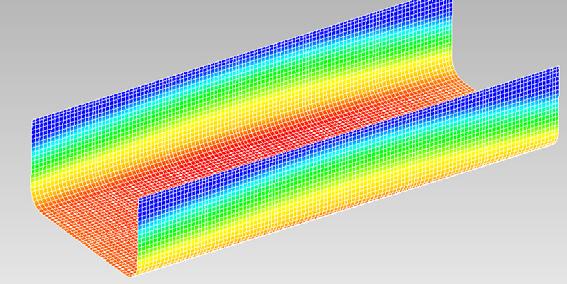
SHIP
and engineering are undergoing a critical paradigm change in this decade. Between decarbonization and digitalization, vessels and offshore assets will increasingly become a system of systems. In the design and engineering process, the designer must take a holistic full life-cycle view of the asset.
connectivity, cloud computing accessibility and edge computing power represent a leap forward beyond the design phase, bringing simulation-based decision-making to real-time situations.

While modeling and simulation offers a significant step in improving engineering and design processes, the rapid concurrent growth of maritime asset
Cloud technology allows the modeling and simulation to be performed at greater scale, complexity and speed. When fed with operational data, models can be fine-tuned to reflect real-life conditions. Modeling and simulation in the cloud serve as the central knowledge base for producing more advanced algorithms and models, which are then pushed to edge devices through reducedorder modeling. These reduced-order models, trained by the corresponding simulation models, can continuously analyze and optimize data from sensors on a system.
Evolving communications technologies such as low earth orbit (LEO) satellites, high altitude platform stations (HAPS), and wireless optical systems will be essential to providing the level of connectivity needed between cloud and edge systems.
On board an offshore asset or marine vessel, edge systems could be used to discover inefficiencies or even predict system failures before they happen. Early detection of a possible problem could help to reduce the chances of a catastrophic failure, saving excess costs and downtime.
In the coming years, modeling and simulations enabled by the growth of cloud and edge technologies and increased asset connectivity will evolve to form a crucial part of the knowledge base for digital twins, which are detailed elsewhere in this publication. These systems have the potential to combine with artificial intelligence to support decision-making, leading to previously unrealized operational efficiencies and improved safety.
Cybersecurity. Protecting maritime assets and ports against cyberattacks is already important to preventing disruptions to design, construction and operation However, as ship connectivity expands and cloud and edge computing capabilities improve, cybersecurity will be essential Vulnerabilities can be addressed with a comprehensive operational technology cybersecurity program that accounts for autonomous operations .
Self-Aware and Self-Maintaining Systems. By applying advanced AI to data collected from improved sensors, selfaware and self-maintaining systems could potentially identify the root cause of anomalies on board marine or offshore assets As autonomous and robotics systems advance, they could eventually perform maintenance or repair tasks with minimal human intervention These functions could possibly act as a key step toward fully autonomous vessel operations
AUTONOMOUS technology allows computers or machines to perform each of the four steps in the operational decision loop — consisting of monitoring, analysis, decision and action — without the need for human intervention. This technology possesses elements of machine intelligence, capable of deciding to take an action free from external control or influence. It could be used to perform a variety of tasks on board marine vessels or offshore assets.
Remote control functions allow the system or operation being monitored to be controlled remotely by a human operator physically located in another vessel or in an onshore control station. This technology could initially serve as a bridge to fully autonomous functions but could also act as human-based monitoring or backup for autonomous systems.
As with many aspects of digitalization, the advancement of autonomous and remote-control functions relies on improvements to a complex web of technologies, including connectivity, sensors and imaging technology, data management and analytics and machine learning and AI tools.
Swarm Mechanics Self-aware SystemAutonomous computing systems can help humans shift away from manual, routine efforts by supporting onboard or remote crews, or by providing fully autonomous, unmanned operations in controlled domains. © Sea Machines.
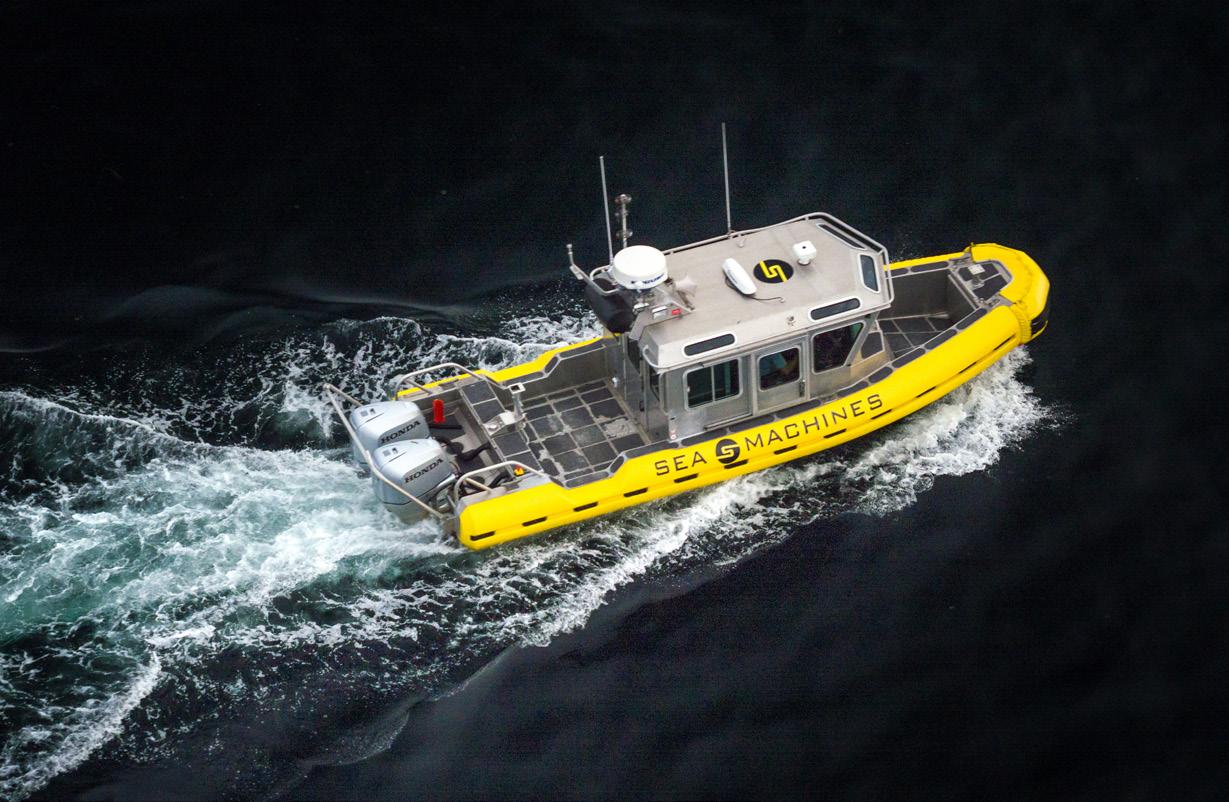
THE IMPLEMENTATION of autonomous and remote-control functions offers several benefits to the industry. The technology has the potential to enhance safety by reducing human involvement in high-risk operations. Initially, autonomous technology could be used to assist in repetitive or dangerous tasks, freeing a seafarer to focus on the overall health and performance of the entire system.
As the technology matures and the industry gains more operational experience, more functions and tasks could be carried out autonomously. While the technology could lower operational expenses related to crew numbers, it could also help attract new talent to the maritime workforce as roles shift to monitoring and controlling systems remotely.
The expanding use of autonomous and remotecontrol functions also has the potential to usher in a paradigm shift for vessel and offshore asset design. As human crew roles are altered or reduced, designs could be optimized to allocate more space and resources to the primary objective and less space to human habitability.
Possible technological advancements in digitalization and sustainability can offer a radical
portrait of future global fleets. A fully autonomous vessel, powered by marinized battery systems, could operate continuously within a global network of autonomous shipping routes for dozens of years with minimal human interaction.
Autonomous vessels connected with each other through a standardized communication protocol — similar to how automatic identification systems (AIS) use self-organized time-division multiple access (SOTDMA) datalinks today — could potentially perform collaborative operations based on swarm behavior. With advanced perception sensors infused with AI, autonomous vessels could detect and identify non-autonomous vessels or obstacles with high accuracy day or night, ensuring the timely execution of collision avoidance maneuvers.
Under any circumstances that the remote operator needs to take control of the vessel, such as for a navigation correction, the operator could use a digital twin to see a real-time visualization of the bridge for remote operations.
A full ecosystem of autonomous vessels, smart ports, smart yards, smart buoys and smart beacons could optimize the supply chain and reduce the risk of incidents at sea.

Biomimicry is a design practice that applies the underlying mechanisms behind naturally occurring efficiencies to improve a design’s performance Technologists have mimicked the hydrophobic structure of the floating fern Salvinia through microbubble technology and hydrophobic hull coatings using nanotechnology to reduce drag Other potential drag reduction use cases could be hull coatings that mimic the roughness pattern of shark skin or the dampening effect of fat on dolphin skin A biomimeticallyoptimized hull could potentially have a substantial impact on sustainable maritime operations
MARITIME assets are complex systems-of-systems. Every system was designed to provide a specific role in a much broader solution, whether that’s transporting cargo across the ocean or producing energy offshore. Effective system design is essential to an efficient asset.
However, systems designed by humans can be sometimes limited by the designer’s knowledge and conventional thinking on aesthetics, structural design or manufacturing. A design might meet requirements and be optimized from the designer’s perspective with a limited number of alternatives, but what if certain human restrictions were removed from the process? How optimized could a design be when the designer is unrestricted by conventional thinking?
Generative design is an AI-driven technology within computer-aided engineering (CAE) that can use countless simulations to create a range of optimized design solutions given a set of constraints, such as manufacturing processes, loads, weight, regulation requirements and other considerations. When combined with additive manufacturing methods, it could enable quick prototyping and testing of radical solutions.
Applied across a system or multiple systems, generative design offers the potential to significantly change the design process for maritime assets from start to finish.
This rendering shows the optimization of an aerospace bracket for additive manufacturing from the design space to a final, optimized geometry with a weight reduction of 63 percent using MSC Apex Generative Design. © Hexagon.

WHILE GENERATIVE DESIGN reduces certain aspects of human limitations in the design process, some human aspects would still be essential to the overall system. Rather than spending substantial hours designing individual components, designers and engineers could shift their focus to optimizing overall system performance. A human designer could also use generative design as a compliment to their own work, considering new perspectives on a whole system.
A possible use case for generative design could be optimizing a propulsion system and the design of various components within it. While components could range in scope from a single bearing to a large crankshaft, the optimization of components should serve to optimize the entire system’s performance.

CAE could be used to find possible weight savings or performance gains without sacrificing the robustness of the system. A human engineer can choose solutions from several simulation-optimized options and approve the overall design.
However, the potential for generative design can go beyond optimizing systems. Marine vessels are systems-of-systems and an optimized propulsion system could lead to further optimization of the entire asset. With all of a vessel’s systems optimized by generative design, complete system-of-systems vessel design could shift in a radical direction limited only by defined constraints.
As CAE technology advances, generative design will play a growing role throughout the design cycle. CAE software could potentially find an optimized design for an entire asset given engineer-provided performance and design constraints. An engineer could ask CAE tools to optimize the design of a cargo carrier of specific tonnage and power it with hydrogen fuel cells. By simulating countless possible combinations and generative designs, the software could offer the engineer several options optimized for the requested purpose.
Nanotechnology is the use of advanced materials on an atomic, molecular and supramolecular scale for industrial purposes Potential applications in the marine and offshore industries could include anti-viral coatings for high-touch surfaces, hull coatings for reducing drag, composite materials for improving strength and carbon nanomaterials for absorbing sulfur in fuel oils . Though adoption of nanotechnology has been held back previously by cost and manufacturing complexity, recent advances have helped reduce costs and increase acceptance
ADDITIVE
(AM) is the process of fusing or joining physical materials to make objects from a computer-aided design (CAD) or digital 3D model. Also known as 3D printing, these systems convert model data into a series of 2D cross-sections and then print a 3D object layer by layer.
Engineers developed the process in the 1980s to expedite prototype development and production. While early AM systems were mainly limited to
polymer-based prints, new printing processes have rapidly evolved to use materials such as metals, ceramics and carbon fiber in the last decade.
The applications for AM have grown alongside its ever-expanding material capabilities. Today, the process is in use in various industries, including automotive, aviation, medical and construction. AM systems put production capabilities in the hands of the end-user, cutting time and costs associated with traditional manufacturing and supply chains.
 Automated, Just-in-time Part Manufacture
Automated, Just-in-time Part Manufacture
Direct metal deposition — advanced additive laser melting and powder spray manufacturing technology for repairing and rebuilding metal workpieces.

AS AM CONTINUES to evolve, the process could revolutionize how the marine and offshore industries handle vessel or individual system repairs. By decentralizing part manufacturing, some repairs or part replacements could be achieved independent of supply chains and far from ports.
On-site or remote AM systems can provide additional value for users by printing parts nearer to the point of need, reducing the woes of traditional logistics and supply chain services. Cloud-based storage of digital part files, coupled with ondemand manufacturing, can now replace large, physical inventories of complex parts. AM systems shift the focus to maintaining blockchain-secured part files on the cloud, managing an inventory of materials or feedstock and printing uniquely serialnumbered parts just-in-time, improve efficiency and streamlining the repair process.
The 3D printing nature of AM systems also provides more flexibility in part design. Printing can be more cost-effective than traditional machining or casting of complex shapes while also providing greater control of material properties. When used with generative design, the benefits can be further enhanced to increase part performance, create
lightweight parts, and provide solutions to part consolidation, whereby systems can now integrate multiple pieces into a single part during printing, further reducing assembly and installation costs.
AM could also integrate with other advanced digitalization technologies to minimize downtime. For example, in the event of an impending noncritical part failure, the onboard systems would be able to self-diagnose and alert an AM machine to start printing immediately. Alternatively, a crewmember could select the part from the digital inventory and start printing at any time.
AM still needs to overcome important challenges — including system cost and space constraints, as-built anisotropic mechanical properties and post-processing requirements — to be viable for marine use. Some of these issues could be alleviated by deploying systems with a tiered approach as technology advances, starting with printing noncritical parts on board vessels.
As AM continues to evolve, systems could eventually produce more critical metal parts or even meet large-scale needs, such as structural or machine components.

Eco-labels help consumers identify products that meet certain environmental performance criteria Examples include the U S Environmental Protection Agency’s (EPA) Energy Star label, which reports on the energy efficiency of appliances and technology products For the maritime and offshore industries, eco-labels could provide insight into the carbon footprint associated with the shipping or production of a product
Green shipping corridors are shipping routes between two major port hubs, including intermediary stopovers, over which the technological, economic and regulatory feasibility of operating zero-emission ships are catalyzed through public and private actions . These corridors offer the opportunity to accelerate progress in tackling the challenges of decarbonizing shipping
WHILE THE International Maritime Organization’s (IMO) emissions-reduction goals and the emergence of various flag State and regional regulations provide great impetus behind the global energy transition, consumers and investors are another critical driving force. Consumers are increasingly conscious of a product’s environmental and social impact, prompting industry players to be more mindful of their environmental, social and governance (ESG) footprint.
The green ecosystem is the infrastructure that supports and enables green transitions for manufacturers, shipyards, ports, shipowners and operators. This infrastructure can include everything from asset design to the adoption of green corridors. A blue economy, on the other hand, is the sustainable use of ocean resources and space, minimizing environmental impact while serving an essential and diversified economic role. These uses can include windfarms, aquafarms, wave or tidal energy systems, and offshore spaceport rocket launching and recovery.
These systems are closely tied together as advancements in green infrastructure and technology will enable improvements for the blue economy and vice versa. Combined, they will serve as essential cornerstones for the broader energy transition and in turn help the industry meet consumer and investor expectations.
THE BLUE ECONOMY has the potential to be a key enabler for a global paradigm shift for maritime industries beyond decarbonization and the energy transition. Sustainable practices are essential to maintaining and promoting growth for the blue economy, as they could serve to attract investments in new infrastructure and bring novel industries and opportunities to marine and offshore sectors.
The proliferation of aquafarms as sustainable food sources may expand significantly in the future. Infrastructure investment in a seafood value chain, including farming, feeding, harvesting, processing, import and retail, must grow to support sustainable aquaculture. Increased construction of offshore aquaculture structures, wellboat fleets and strategically-located onloading and offloading facilities could enable the growth of aquafarms within the blue economy.
The growth of commercial space exploration can similarly impact the blue economy. Satellite launches, many of which support growing broadband connectivity in remote locations, have increased exponentially in the last decade. As a result, offshore spaceports and the infrastructure needed to support them could play an important role in the industry’s impact on ocean space.
The carbon footprint of the infrastructure, including the sustainable transport of crew, fuel and equipment, will need to be considered as the industry grows.
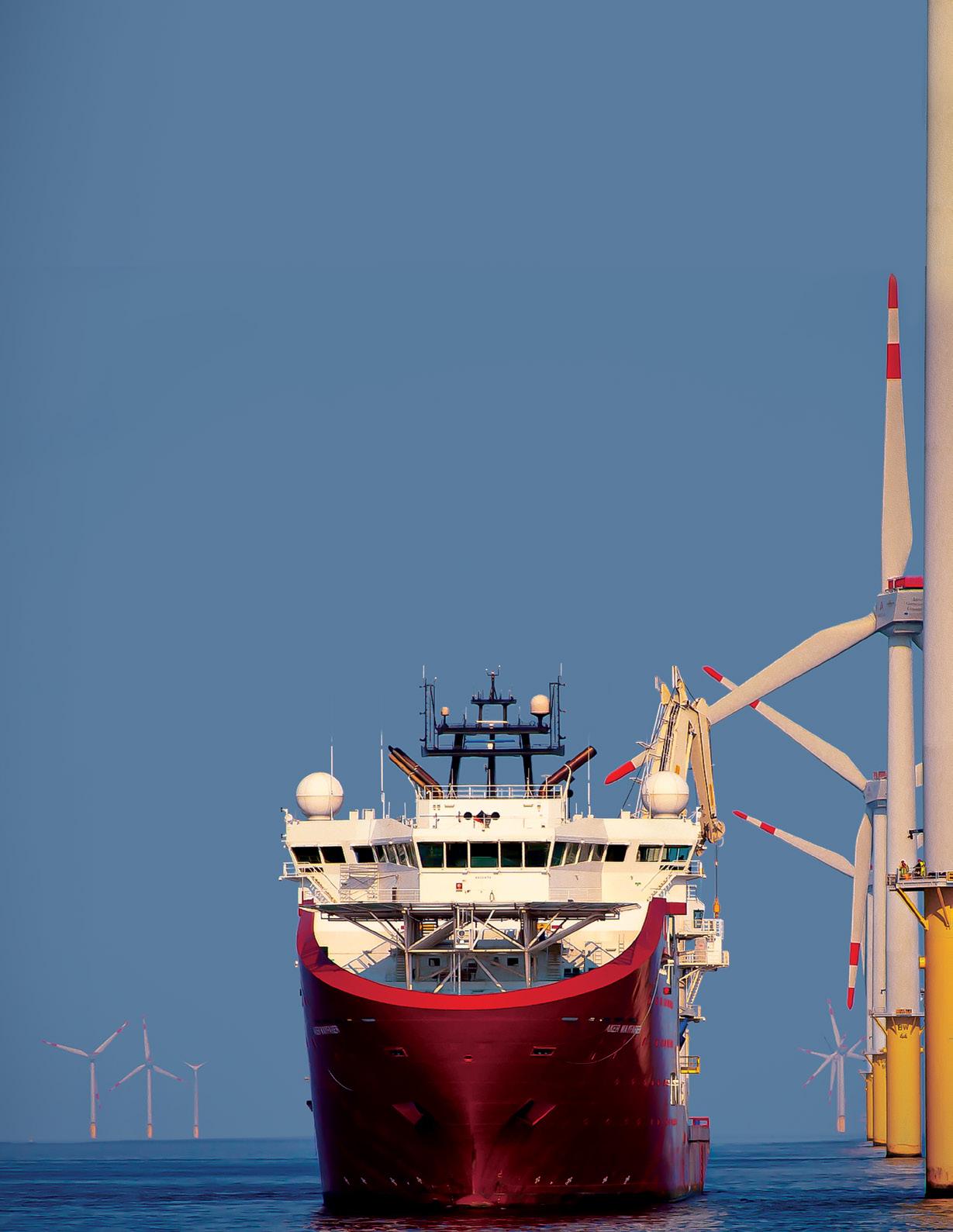
The blue economy could also play an important role in the maritime industry’s broader energy transition. Offshore windfarms, wave energy conversion facilities and tidal energy harvesting facilities can tap into the ocean’s immense renewable energy potential.
Renewable energy sources, as well as investment in associated infrastructure, are essential to the growth of the green ecosystem and green shipping corridors. Battery charging substations and hydrogen hubs could provide essential logistics infrastructure and alleviate some of the challenges associated with alternative fuel storage.
Establishing green ecosystems could help marine and offshore industries adapt to meet consumer needs and, by extension, help drive more investments into green technologies and infrastructure. The growing popularity of green shipping corridors, intended to highlight low- and zero-emission vessels with special trade routes between major green ports, will be significant in implementing sustainable infrastructure and technologies.

IMO Targets. The Initial IMO strategy on the reduction of GHG emissions from ships includes two key goals The first goal is to reduce CO2 emissions per transport work, at an average across international shipping, from 2008 levels by at least 40 percent by 2030 and 70 percent by 2050 The second goal is to reduce the total annual GHG emissions from international shipping by at least 50 percent by 2050, also relative to 2008 levels As the needed infrastructure for alternative fuels is developed, onboard carbon capture and storage technologies can potentially help bridge the gap to the IMO’s net-zero targets
CARBON CAPTURE, Utilization and Storage (CCUS) is a process that aids in reducing GHG emissions by capturing CO2 from point sources, such as engine exhaust, and either using it to create other products or storing it permanently in underground geological formations.
Countries and industry bodies have recognized carbon capture technologies as a way to move toward net-zero emission targets while continuing to use hydrocarbon resources. Therefore, policy
Carbon capture transport overview. Provided by Global CCS Institute.

support has been increasing to aid the deployment of these technologies.
However, deploying CCUS has been slow due to limited activity in commercializing the technology. The IMO’s 2030 and 2050 emissions-reduction goals, along with broader global interest in reducing the effects of climate change, have prompted the development of new CCUS technologies that are at an early stage of commercialization with considerable potential to reduce costs, increase efficiency and enable safe operations.
regarding capturing CO2 on board vessels or at purpose-built capture facilities on shore. Amine-based, carbon capture technology existed previously and is a potential carbon capture option for the maritime industry, but it presents some challenges related to the storage and transportation of liquefied CO2
Carbon capture that uses calcium oxide (CaO) to absorb CO2, resulting in calcium carbonate (CaCO3) pellets, is another potential solution that is being studied. Capturing and storing the CO2 as CaCO3 pellets would make transportation and storage of a bulk material easier than maintaining the refrigeration and pressure needed to store liquefied CO2
Stored CaCO3 could be sold to other industries — it has applications in the pharmaceutical, agriculture and mining sectors, among others — or further processed to separate the CO2 and CaO in an onshore processing facility. After offloading its stored CaCO3, a vessel equipped with carbon capture would reload fresh or recycled CaO.
The separated CO2 could be transported for other industrial applications, such as enhanced oil recovery (EOR) or the food and beverage industry. Surplus CO2 could be stored in empty oil or gas reservoirs or deep salt formations. Other innovations for using CO2 in producing chemicals and building materials could also emerge to take advantage of the excess supply.
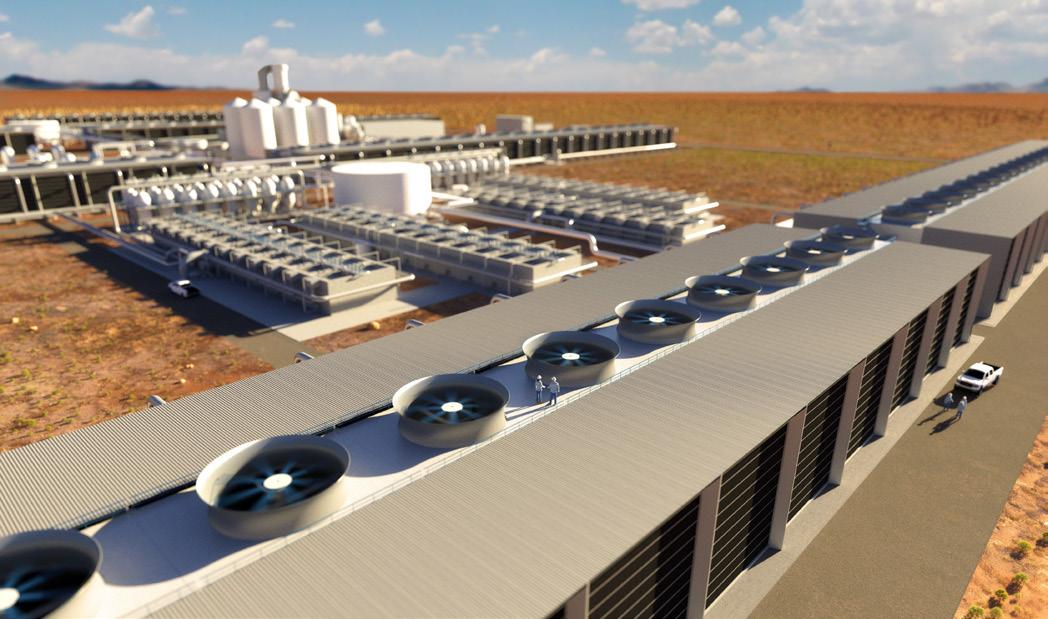

As the industry works toward meeting the IMO’s goals, CCUS will play an important role in reducing emissions in both carbon-intensive processes and in the growing use of low-carbon fuels, such as liquefied natural gas (LNG), methanol or biofuels. CO2 capture is also essential to the production of fuels like blue hydrogen and ammonia, which could power the next generation of maritime assets.
An increase in onshore CO2 capture plants and the use of onboard CCUS systems can play a pivotal role in setting the industry on the path to a clean and sustainable future.
Carbon Engineering’s Direct Air Capture (DAC) technology is a form of carbon capture that pulls CO2 directly from the air. The captured atmospheric CO2 can be permanently and safely stored underground to deliver negative emissions, or used to produce low carbon intensity products, such as fuels, that are drop-in compatible with vehicles, ships and infrastructure today. © Carbon Engineering Ltd.
Non-Lithium-Ion Batteries. Lithium-ion batteries use an electrochemical intercalation process where lithium ions move from the negative electrode to the positive electrode during the charging and discharging cycle

Non-lithium-ion batteries include alternatives such as zinc-ion, sodium-ion and dual carbon batteries which utilize anodes and cathodes made from a different material These technologies offer the potential to overcome some of the challenges associated with lithium-ion batteries, such as reducing reliance on precious elements like nickel or cobalt
AS THE INDUSTRY charts various paths to decarbonization, increased electrification via advanced ESS will be an essential step to net-zero emissions. While many vessels already use ESS in some form to power electrical equipment, current systems are limited in scope and typically charged using fossil fuel-burning engines or generators.
The increased energy demand for electrified propulsion systems or onboard carbon capture combined with the overall path to decarbonization will necessitate an improved ESS, charged with renewable energy.
A combination approach of using various renewable energy systems together offers a possible solution to meet increased needs.
ESS technologies such as batteries, kinetic ESS, compressed air energy storage (CAES), super capacitors and superconducting magnetic energy storage (SMES) are possible options with broad application potential. Such systems could be charged onshore or in offshore charging stations and then paired with green hydrogen production systems and fuel cells to provide zero-emission energy to marine vessels or offshore assets.
THE USE OF HYBRID technology is not new. Still, the combination of advanced ESS and green hydrogen production can serve as a powerful system for driving the green hydrogen generation market. As this technology develops, hydrogen and ESS arranged correctly can power the next generation of marine vessels and offshore facilities, thus reducing the use of fossil fuels, lower GHG emissions and potentially decrease the cost of energy overall.
A kinetic ESS could be used to power the production of green hydrogen — with electrolysis — or other green fuels. The hydrogen could then be consumed in fuel cells to power various marine or offshore systems. Continuous onboard hydrogen production could alleviate many of the fuel’s transportation and storage challenges.
By using renewable sources for onshore or offshore charging of a kinetic ESS, the potential exists for a chain of continuous green energy production.

In the early stages of the technology, a combination of kinetic ESS and fuel cell systems could be used for powering onboard carbon capture or possibly short transits, such as inland waterways, along coasts or nearby ports. It could also power various systems on board offshore assets.
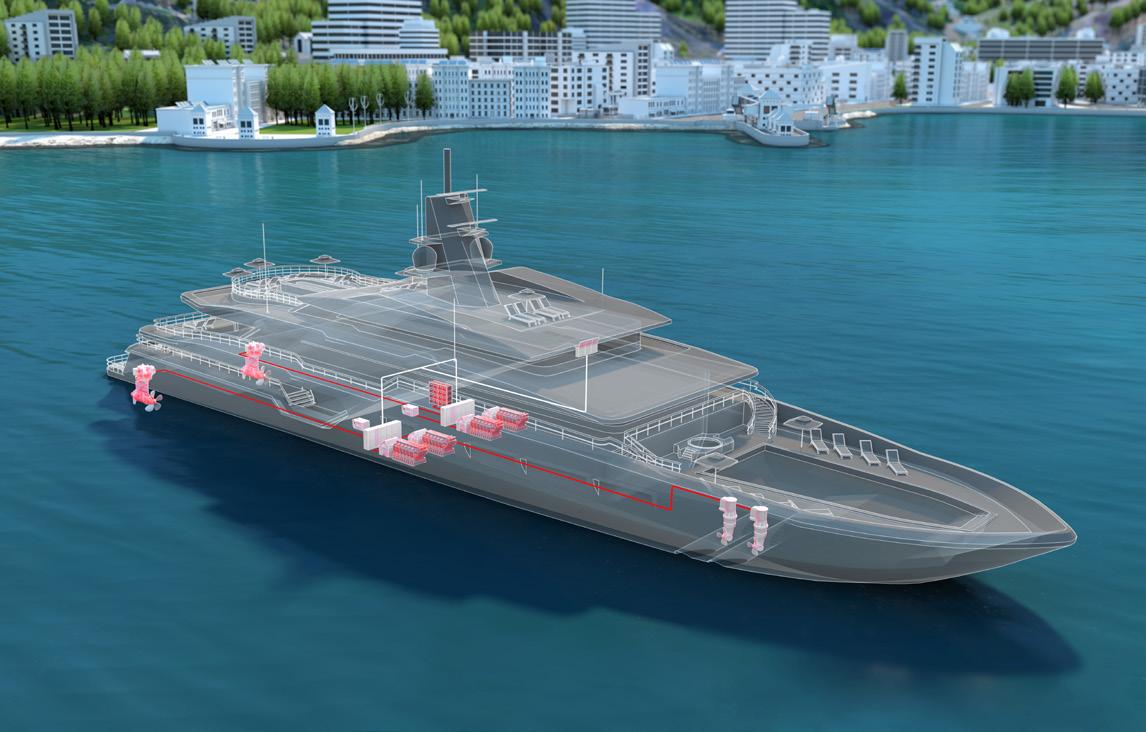
As green infrastructure grows and expands, the potential exists for ESS technology to advance and be used on board longer, deepsea transits around the globe. A network of deep-sea charging stations or hydrogen production and storage hubs could support these longer transits.
Vessels and offshore assets must adopt some level of electrification as the industry continues the path toward net-zero emissions. Newly constructed and retrofitted assets will be equipped with various combinations of ESS, fuel cells and alternative fuels. Advancements in these technologies will be vital to decarbonizing the global fleet.
Concept illustration of the Azipod® propulsion system onboard a sustainable superyacht. This electric drive propulsion system is proven to cut fuel consumption by up to 20 percent compared to traditional shaftline propulsion systems. © ABB.
Hydrogen hubs are a network of hydrogen producers, consumers and connected infrastructure that could support the production, use and storage of hydrogen as a fuel or energy source Blue hydrogen refers to hydrogen produced by burning LNG and capturing the resultant carbon emissions Green hydrogen refers to hydrogen produced using renewable sources such as wind energy Clean hydrogen hubs could be located near a renewable energy source to power a production process like electrolysis
IN 2018, the IMO set initial targets for reducing the shipping industry’s GHG emissions. This focused the industry on finding solutions that will help meet the IMO’s 2030 and 2050 goals.

Organizations have researched and suggested several possible solutions for reducing emissions in recent years, ranging from scrubber systems to blended fuels. While such solutions can play an initial role in the broader energy transition, low-
and zero-carbon alternative fuels will be crucial to the industry’s journey to net-zero emissions by 2050.
Despite near-term challenges related to production, transportation and storage, hydrogen offers a promising solution for zero-emissions, tank-towake (TTW) operations. Investment in the complete hydrogen value chain, especially in producing blue and green hydrogen and relevant operational infrastructure, will be vital to scaling hydrogen as a true well-to-wake (WTW) solution.
HYDROGEN consumed in fuel cells has the potential to provide vessels with zero-emissions energy. As fuel cell technology advances, hydrogen could offer an emission-free TTW energy solution for propulsion or other emissions-lowering processes, such as onboard carbon capture.
Until renewable sources scale up, the production of blue hydrogen will be pivotal to its adoption as a zero-emission WTW fuel. In short and medium terms, renewable and conventional fossil energy will combine to form a blended fuel type. In this way, the industry can gradually transition to the hydrogen paradigm rather than an abrupt switch. As carbon capture technology improves and renewable energy production grows, blue and green hydrogens can
scale to provide marine vessels with a complete zero-emission WTW solution.


However, even if hydrogen isn’t broadly adopted as a marine fuel or — more likely — is one of many zero-emission options, it can still serve as a valuable puzzle piece in all pathways for our energy transition. It’s a building block for other possible fuels like ammonia and green methane.
Replacing traditional carbon-based fuels will take time. It will take decades of technological advancement and production scaling of alternative fuels like hydrogen to reach a point of large-scale maturity. However, there are still critical near-term roles for the carbon and hydrogen value chains to impact the global energy transition.
NUCLEAR POWER offers a potential zero-emission energy solution for vessels and floating offshore assets. Advanced, modular nuclear reactors could generate significant amounts of energy from a relatively small, portable plug-and-play platform.
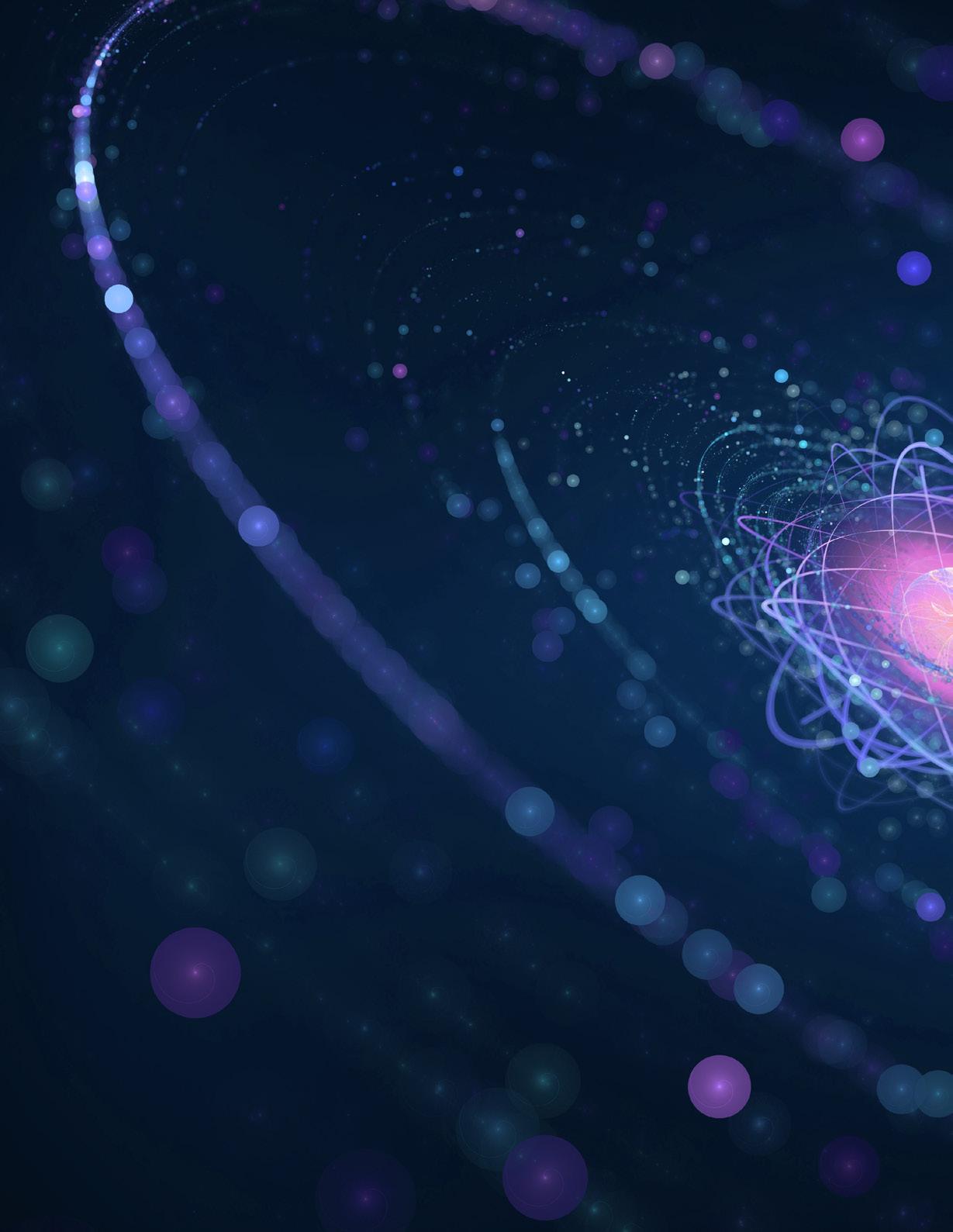
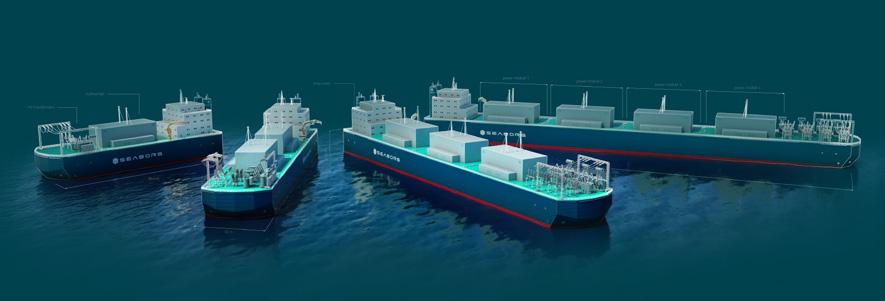
Several organizations are actively developing different types of small nuclear systems, including heat pipe reactors (HPR) and molten salt reactors (MSR). A single system could power a vessel or provide energy for alternative fuel production for dozens of years before refueling, replacing it with another reactor. Modularity,
design standardization, and operational independence with minimal personnel interaction or maintenance make nuclear energy a potential effective power solution for vessels and offshore installations.
However, the broad adoption of nuclear power could face several challenges and consequences. Regulations on the use and transport of radioactive material will need to change at the local, national and international levels for the use of nuclear energy on commercial assets to be viable. Regulatory bodies would also need to address the increased volume of nuclear waste as more vessels adopt the technology.
Seaborg Technologies developed new barges powered by compact molten salt reactors (CMSR), which will produce clean electricity for electric grids or hydrogen production. © Seaborg Advanced nuclear reactors feature modern designs that could add inherent safety, reduce nuclear waste products, eliminate fuel proliferation concerns, increase fuel and thermal efficiency, enhance reliability, and optimize reactor size and arrangements for modular transport and mass production The development of advanced nuclear reactors could help drive further use of nuclear energy on board maritime assetsAS THE DEVELOPMENT of small nuclear energy systems continues and regulations evolve, the potential exists for a portion of the world’s commercial fleet to adopt nuclear power as a zero-emissions energy solution in the future.
While nuclear systems will likely represent high initial costs relative to legacy energy systems, shipowners and operators could quickly experience other savings validating switching. Nuclearpowered vessels will avoid the taxes and fees associated with carbon emissions and the emerging carbon economy. Bunkering service will also be unnecessary for such vessels, eliminating costs, issues and safety risks related to the practice.
Nuclear energy is not entirely new to marine vessels, though it is primarily limited to government and naval ships. However, these vessels use conventional reactors that require special precautions during a lengthy refueling and refitting process. Many small reactors under development aim to make the refueling process as simple as replacing an alkaline battery in a child’s toy.
When a reactor nears the end of its life on board a vessel or offshore asset, a specialist or possibly even an autonomous system could remove the old system and install a new one, minimizing downtime. The responsibility of handling radioactive waste could then be pushed to the operators of a centralized nuclear waste repository rather than the shipowners and operators.
Because nuclear reactors are expected to power ships for 15 to 20 years or more and commercial ships are often outdated or replaced within 30 years, a reactor could outlive the vessel on which it’s installed. Older ships equipped with nuclear systems could find new life by connecting to onshore electricity grids and providing offshore zeroemission energy for several years.
Nuclear power offers the potential to extend the life of aging vessels, free onboard space with optimized arrangements and eliminate emissions, making it a possible game-changing emerging technology for the industry.
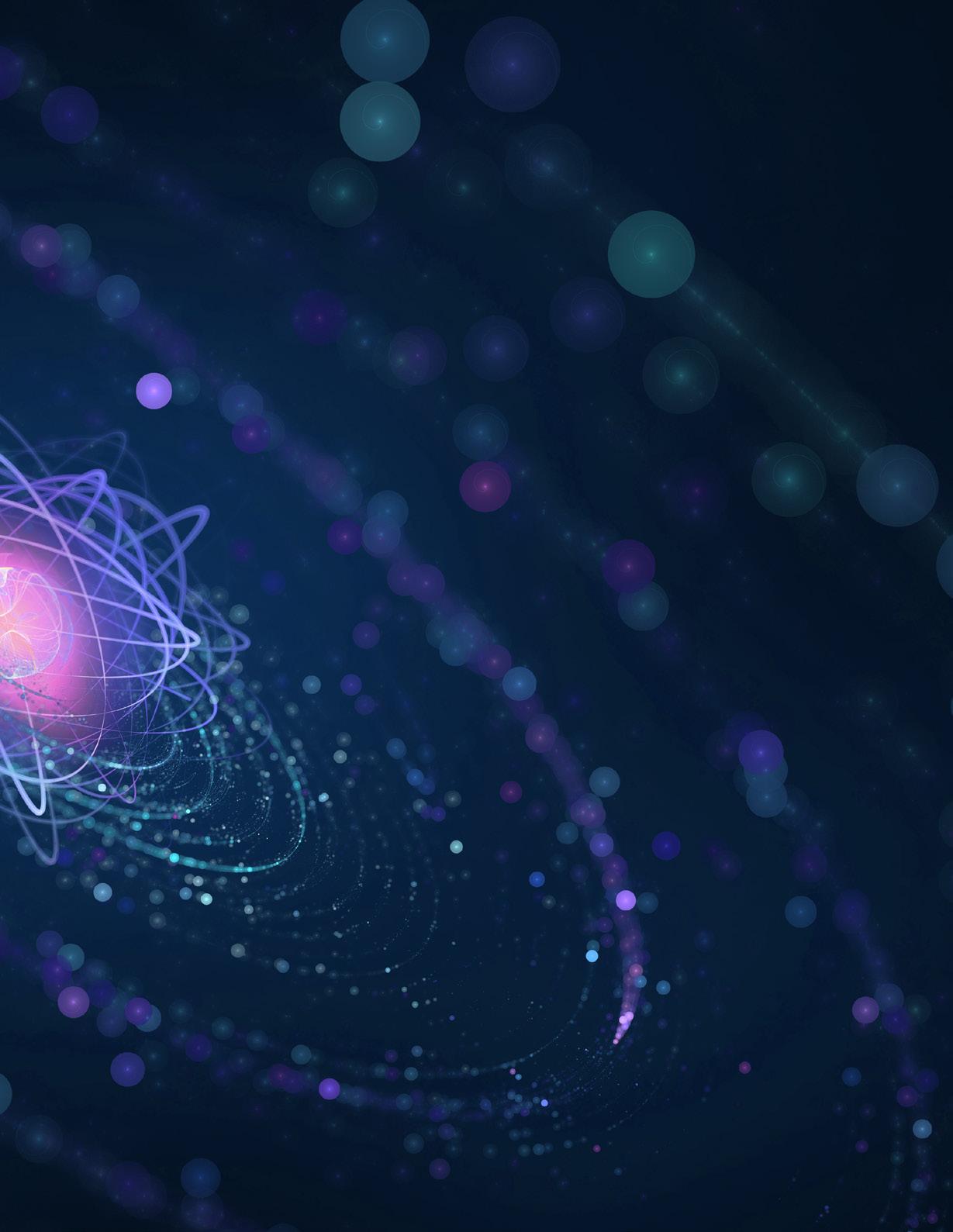
This cut-away rendering of the MIT nuclear battery concept shows important components such as the instrumentation and control module, the reactor, and the power module. Courtesy of R. Freda.

EUROPE REGION
111 Old Broad Street London EC2N 1AP, UK
Tel: +44-20-7247-3255
Email: ABS-Eur@eagle.org
NORTH AMERICA REGION
1701 City Plaza Dr. Spring, Texas 77389, USA
Tel: +1-281-877-6000
Email: ABS-Amer@eagle.org
SOUTH AMERICA REGION
Rua Acre, nº 15 - 11º floor, Centro Rio de Janeiro 20081-000, Brazil
Tel: +55 21 2276-3535
Email: ABSR io@eagle.org
STEAMSHIPS USHERED IN a new era of global trade 200 years ago. Today, we stand at the precipice of not just a singular leap forward, but a watershed of emerging technologies that will revolutionize the marine and offshore industries.
From development of renewable energy and emission-reduction strategies to autonomous functions and digital twins, ABS is working with innovators around the globe to support a wide variety of new technologies and innovations to help the industry meet key deadlines on the journey to net-zero emissions by 2050.

ABS and its affiliated companies work with clients in the marine, energy and government sectors to create a safer, cleaner future at sea. We support the development of practical solutions for the industry’s most daunting technical and operational challenges.
We set out more than 160 years ago to promote the security of life and property at sea and preserve the natural environment. Today, we remain true to our mission and continue to support organizations facing a rapidly evolving seascape of challenging regulations and new
technologies. Through it all, we are anchored by a vision, mission and core traits that help our members and clients find clarity in uncertain times.

ABS is a global leader in marine and offshore classification and other innovative safety, quality and environmental services. We’re at the forefront of supporting the global energy transition at sea, the application of remote and autonomous marine systems and many more exciting technology advancements. Our commitment to safety, reliability and efficiency
is ever-present, guiding our members and clients to safer and more efficient operations.
We support the maritime industry’s digitalization, clean energy transition and application of new technologies through several joint development projects and research initiatives. Asset owners and operators considering new technologies like those featured in this publication can contact our specialists to learn more about how ABS can help.
1701 City Plaza Dr. I Spring, TX 77389 USA 1-281-877-6000 I www.eagle.org © 2022 American Bureau of Shipping. All rights reserved.
